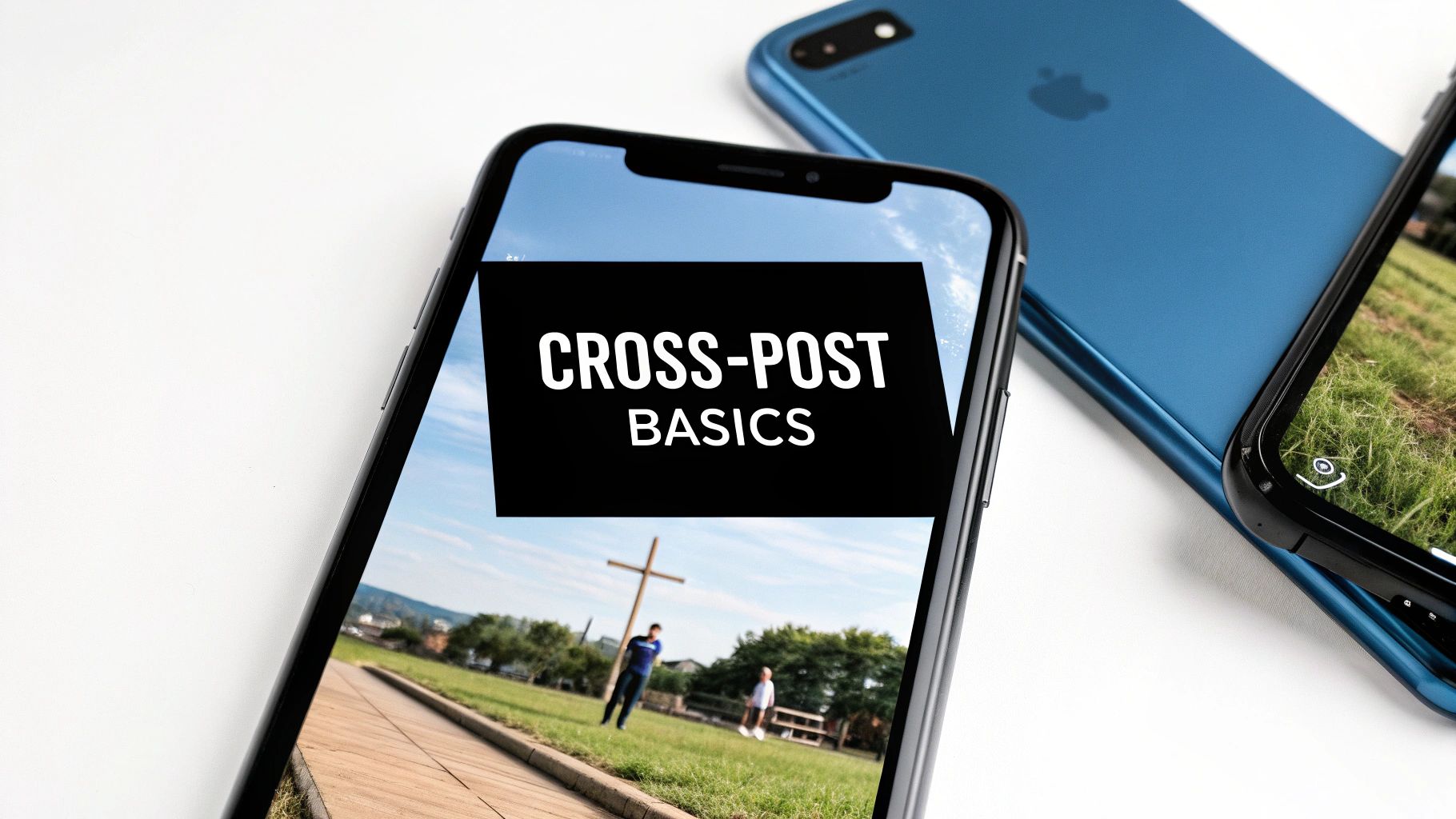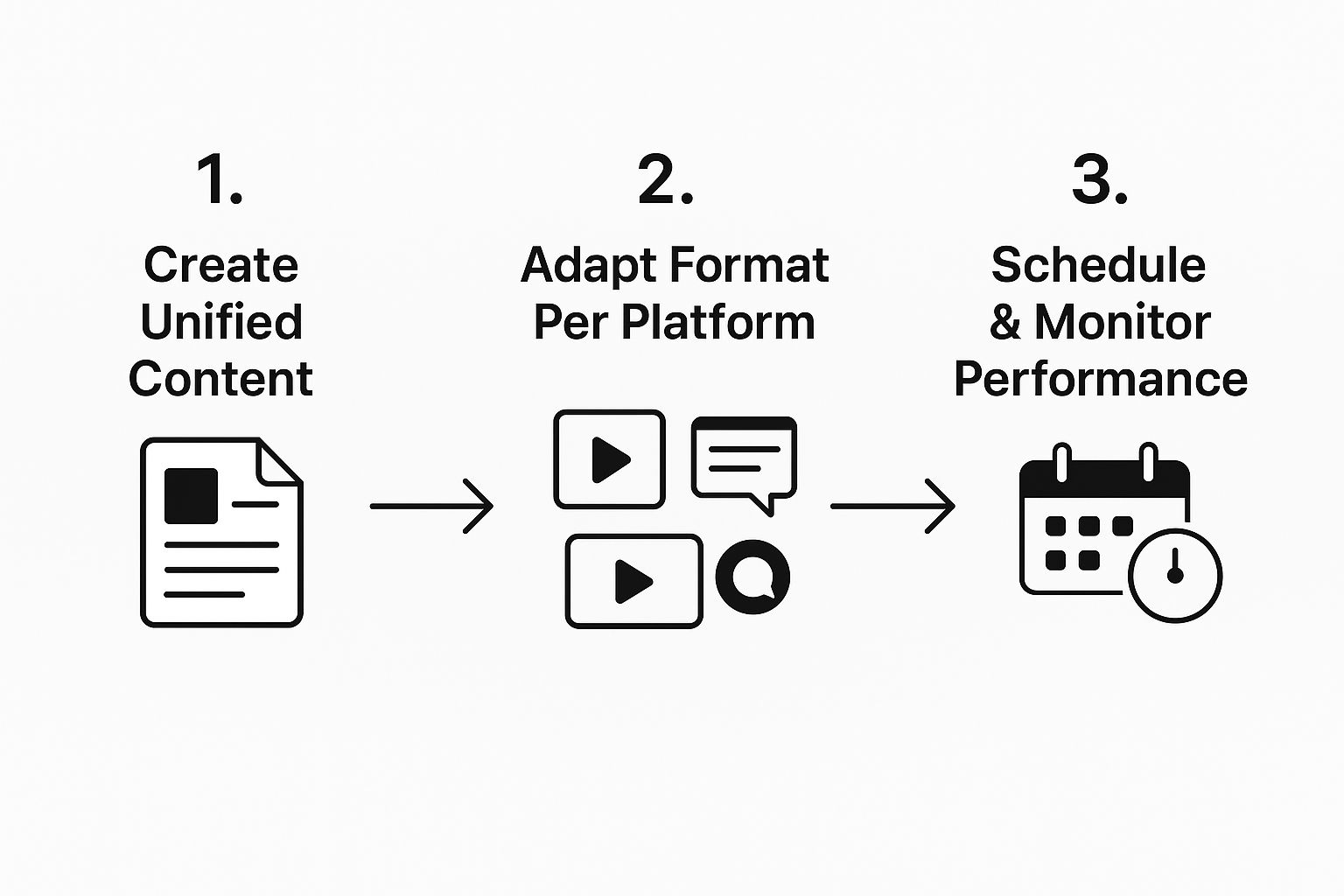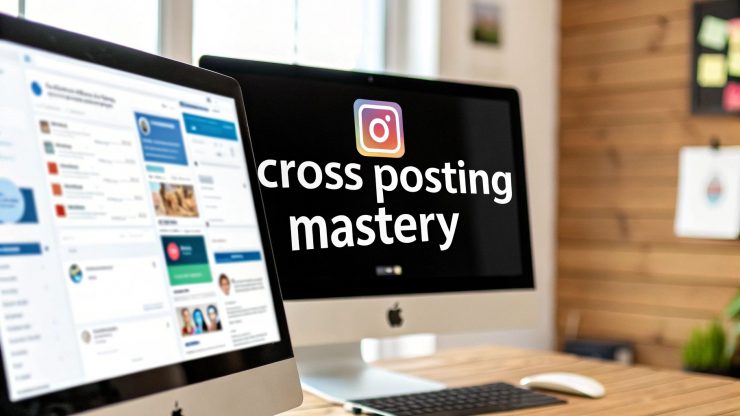Sharing the same piece of content across different social media platforms is what we call cross-posting. When it's done right, it's a powerful way to get your message out there and keep your brand consistent, all without chaining yourself to your desk all day.
Why Smart Cross-Posting Is a Game Changer

A lot of people get this wrong. They think cross-posting is just copying and pasting the exact same message everywhere. That lazy approach is a fast track to getting ignored because it completely overlooks what makes each platform unique—its audience, its culture, and its unwritten rules.
Strategic cross-posting is the smarter play. It’s all about efficiency mixed with a little bit of finesse.
You start with a core idea, a great piece of content, and then you tweak it to fit each social network. This way, your brand voice stays solid and consistent, but the delivery feels completely natural on every platform. It's like telling a great story to different groups of friends—you don't change the story, but you might change your tone or the details you emphasize.
Maximizing Your Content ROI
Think about it: every blog post, video, or case study you create is a real investment. It costs you time, energy, and money. Smart cross-posting helps you squeeze every last drop of value out of that investment. A piece of content doesn't just have one shot on one platform; it gets a chance to shine again and again.
This dramatically extends your content's lifespan and reach. By sharing slightly different versions across your channels, you’re able to connect with various segments of your audience right where they hang out.
Building a Cohesive Brand Identity
Consistency is everything when it comes to building a brand people recognize and trust. When your followers see a unified message and look across LinkedIn, Instagram, and X, it strengthens your brand identity. This doesn’t mean every post is a carbon copy, but they should all feel like they came from the same place.
Good cross-posting nails this balance, giving you cohesion without being boring. It helps you:
- Reinforce Core Messaging: Your main value props stay top-of-mind, no matter where people find you.
- Maintain Visual Consistency: Using your brand colors, fonts, and style of imagery creates a look that's instantly yours.
- Save Valuable Time: You get back hours you would have spent posting manually, freeing you up to focus on the bigger picture, like strategy and actually talking to your community.
The core benefit is simple: you post once and distribute that message to multiple audiences, broadening your reach without multiplying your effort. This efficiency is critical for maintaining a strong social presence in today's crowded digital spaces.
This whole strategy of adapting content for different platforms has become a must-do for anyone serious about social media management. It’s the answer to the constant pressure of keeping channels like Facebook, TikTok, and LinkedIn buzzing with fresh, engaging content. As experts at Social Champ point out, a unified strategy is key.
Ultimately, smart cross-posting on social media is about working smarter, not harder, to make a bigger impact.
Building Your Cross-Posting Content Strategy

Before you touch any automation tools, you need a solid game plan. A great cross-posting strategy doesn't start with scheduling—it starts with knowing your core message and how to make it sing for different audiences. If you rush this part, it's like building a house without a blueprint. It's just not going to work.
A good way to think about this is to define your content "pillars." These are the major themes your brand is all about. For instance, if you're a fitness coach, your pillars could be workout tutorials, nutrition advice, and motivational stories. Every single thing you post should tie back to one of these pillars.
With your pillars in place, the real strategy begins: figuring out how one great idea can be remixed and reimagined across all your channels. This is so much more than just resizing an image. It's about translating your core message into the native language of each social network.
From One Idea to Many Posts
Let's say you just published a big blog post: "5 Common Kettlebell Mistakes and How to Fix Them." This is your anchor piece of content. Instead of just spamming the link everywhere, you get creative.
- LinkedIn: This is where you spark a professional conversation. You could pull out one crucial mistake, write a text-only post about how it impacts long-term fitness goals, and then ask your network of fellow professionals for their own insights.
- Instagram: It's a visual playground. Create a slick five-slide carousel where each slide shows the wrong way versus the right way to do a kettlebell swing. Your caption should be punchy and loaded with relevant hashtags like #KettlebellWorkout and #FitnessTips.
- TikTok or Reels: This is all about fast, engaging video. You'd film a snappy, 15-second clip demonstrating the single most dangerous mistake and how to fix it, all set to a trending audio track to maximize your reach.
This method makes every post feel like it truly belongs on that platform, which is exactly what drives engagement. You're giving users what they expect to see in their feeds, making your content feel genuinely helpful, not just another ad.
Planning for Platform Nuances
To really nail cross-posting, you have to think like a user on each platform. The person scrolling through professional articles on LinkedIn has a completely different mindset than someone looking for a quick laugh on TikTok. As you build out your strategy, it’s critical to brainstorm engaging social media content ideas that cater to these unique user expectations.
The goal isn't just to be present everywhere; it's to be relevant everywhere. Adapting your tone, format, and call-to-action for each network isn't optional—it's essential for success.
To make this practical, I use a simple framework to guide how I adapt a single piece of content. It helps keep everything consistent yet platform-specific.
Platform Content Adaptation Framework
| Platform | Optimal Format | Recommended Tone | Example CTA |
|---|---|---|---|
| Text-heavy post, article, or document | Professional, insightful, educational | "What are your thoughts on this? Share in the comments." | |
| High-quality image, carousel, or Reel | Aspirational, polished, community-focused | "Save this post for your next workout! 📌" | |
| Video, curated links, community questions | Conversational, helpful, friendly | "Tag a friend who needs to see this!" | |
| TikTok | Short-form vertical video (7-15 sec) | Entertaining, trendy, authentic | "Try this and duet me with your results! 👉" |
| X (Twitter) | Short text updates, GIFs, threads | Witty, timely, concise | "RT if you agree!" |
This framework isn't rigid, but it serves as a powerful starting point to ensure you're not just copy-pasting your content across the board.
The sheer volume of content out there makes this strategic thinking non-negotiable. With people spending a collective 14 billion hours on social media daily, you have to be smart to get noticed. This is where AI-assisted content adaptation is becoming a game-changer; in fact, 73% of businesses see better engagement when using it to tailor their posts. You can dive deeper into the latest social media stats over at Talkwalker.com.
Your strategy needs to be a living document that anticipates these differences from day one. That foresight is what separates the brands that flourish with cross-posting from those that just end up spamming their followers.
Automating Your Workflow with Buffer
Once you've got your strategy nailed down, it's time to put it into action. This is where the right tools make all the difference, turning a great plan into a workflow that actually works without burning you out. For cross posting social media content, a platform like Buffer is an absolute game-changer.
Your first step is to get all your social accounts hooked up. It's a quick, painless process—just a few clicks to authorize Buffer to post for you on Instagram, LinkedIn, Facebook, X, and whatever other platforms you're using. It's like giving your new virtual assistant the keys to the kingdom.
With everything connected, you'll see all your channels laid out in a single, clean dashboard. This unified view is where the time-saving really begins. No more bouncing between a dozen different apps and browser tabs.
Crafting and Customizing Your Posts
The real power of Buffer is in its post composer. This is your canvas for creating that core post you mapped out in your strategy. Let's say you're sharing a new blog post. You'll write the main caption, drop in the link, and upload your key visual—maybe a slick graphic or a relevant photo.
But don't just blast it out everywhere. This is the part that separates smart cross-posting from lazy duplication. Buffer lets you tweak that single post for each social network, all from the same screen.
It’s surprisingly simple. You just toggle between your connected accounts and make your edits.
- For LinkedIn: You’ll likely want to dial up the professionalism. Expand the caption with some business-focused insights, use niche industry hashtags, and maybe tag a relevant company or influencer.
- For Instagram: It's all about the visuals here. You might swap that single graphic for a carousel of a few key takeaways from the blog post. The caption can be more casual, and you could end with a question to get the comments rolling.
- For X (formerly Twitter): You have to be concise. Chop down the text to get straight to the point, maybe add a clever GIF to catch the eye, and use a couple of high-volume hashtags to tap into bigger conversations.
This approach gives you a clear path for adapting your content before it ever goes live.

Following this process ensures that while your message stays consistent, the delivery feels completely natural on each platform. That's how you get people to actually stop scrolling and engage.
Scheduling for Maximum Impact
Once your posts are tailored, the final piece of the puzzle is scheduling. Buffer’s queue system is brilliant for this. You can set up a unique posting schedule for every social account. For instance, maybe you’ve found your LinkedIn audience is online during business hours on weekdays, but your Instagram crowd is most active on weekend afternoons.
By tailoring your schedule to each platform's peak engagement times, you ensure your carefully crafted content gets seen by the maximum number of people. It’s a small adjustment that can have a significant impact on your reach and results.
After you've added your customized posts to their respective queues, you can breathe easy. Buffer takes over from there, publishing each post at the perfect time for that specific channel. This "set it and forget it" approach frees you up to do what really matters: analyze what's working and actually talk to your community. If you want to get even more out of the tool, this step-by-step guide to using Buffer for your social media is a fantastic resource.
Using a tool like Buffer transforms cross-posting from a repetitive chore into a smart, efficient system for getting your content in front of the right people.
Nailing the Platform-Specific Tweaks (This is Where the Magic Happens)
Great cross-posting isn’t just about pushing the same message everywhere. It's about making every single post feel like it was born on the platform it lives on. This is what separates content that gets scrolled past from content that actually sparks a conversation.
Let’s be honest, we can all spot a lazy, one-size-fits-all automated post from a mile away. It feels robotic and disconnected, and it’s a surefire way to make your audience tune out.
Think of your core piece of content—a blog post, a new podcast episode—as your raw material. For each social network, you’re going to reshape and refine it to match the local culture. It’s not about reinventing the wheel every time; it’s about smart, strategic adaptation.
Imagine you just published a killer guide on B2B sales strategies. The amateur move is to just copy and paste the title and link across every channel. But a pro plays it differently.
Speaking the Language of LinkedIn
On LinkedIn, you're in a professional's world. Your tone needs to shift from a broad announcement to a focused discussion starter.
- Rework Your Hook: Ditch the clickbait and open with a sharp question or a bold statement that hits on a common industry pain point. For our B2B guide, you might start with: "Is cold outreach officially dead, or are we just doing it wrong?"
- Use the Right Hashtags: Forget generic tags. Get specific with industry-focused hashtags like #B2BSales, #SalesStrategy, and #LeadGeneration. This is how you get your content in front of the right eyeballs.
- Frame it as Professional Value: Position your content as a solution to a business challenge, a new industry insight, or a tool for career growth. You want people to see it and think, "This will help me do my job better."
This simple reframing instantly elevates your post from a simple share to an expert take.
Cracking the Code for Instagram
Instagram is a whole different ballgame. It's visual, personal, and story-driven. That corporate jargon from LinkedIn? It'll fall completely flat here.
For that same B2B sales guide, a total transformation is in order.
You could pull out three key stats or tips and turn them into a slick, easy-to-read carousel. Each slide gets a clean icon and a tiny bit of text. The real work happens in the caption, where you need to connect on a human level.
Instead of talking about corporate metrics, reframe the advice around personal achievement. A caption could read: "Struggling to hit your numbers this quarter? Swipe through for 3 mindset shifts that helped our team close bigger deals. Which one will you try first? 👇"
See the difference? We shifted the focus from the business's success to the user's personal success. That’s how you make content feel native to Instagram.
Using Native Features to Your Advantage
The absolute best cross-posting strategies dive deep into the unique features each platform offers. Pushing a static image and text everywhere means you're leaving powerful, algorithm-friendly tools on the table.
Here's how to start thinking about it:
- X (Twitter) Threads: Does your blog post have several distinct points? Perfect. Turn them into a Thread. Each tweet builds on the last, creating a mini-story that hooks readers and keeps them on your profile longer.
- Instagram Reels: Find the single most impactful takeaway from your content and create a quick, punchy 15-second Reel. Slap some trending audio on it, use on-screen text, and you’ve got something highly shareable and digestible for the fast scroll.
- LinkedIn Articles: If your original post is a substantial, thought-leadership piece, consider republishing a version of it as a LinkedIn Article. This native format is heavily favored by the algorithm and can expose your work to a massive professional audience beyond your immediate network.
When you lean into these native formats, your content doesn’t just get posted on a platform—it actually thrives there.
How to Know If Your Cross-Posting Is Actually Working

Getting your cross-posting automated is a huge win for saving time, but it's only half the job. If you just set it and forget it without looking at the numbers, you’re basically flying blind. The whole point is to create a feedback loop—what you learn on one platform should make your content better everywhere else.
This doesn't have to be some overwhelming data-science project. Most good scheduling tools, like Buffer or the one you're using, have built-in analytics that show you exactly how each post is doing. Think of this as your command center for figuring out what your audience on each network really wants to see.
Cut Through the Noise: Focus on These Metrics
It's easy to get lost in a sea of "vanity metrics" that look nice but don't mean much. To get a real sense of what's working, you need to zero in on the numbers that signal a genuine connection with your audience.
Here’s what I always keep a close eye on:
- Engagement Rate: This is the big one. It bundles up the likes, comments, shares, and saves, showing you how compelling your content truly is. A high engagement rate means people aren't just seeing your post—they're acting on it.
- Reach and Impressions: In simple terms, reach is the number of unique people who saw your post, while impressions are the total number of times it was viewed. These are your best indicators for brand awareness and content visibility.
- Click-Through Rate (CTR): If your post includes a link, the CTR tells you what percentage of viewers were interested enough to actually click it. This is mission-critical for driving traffic back to your website or a landing page.
The Real Magic Is Turning Data Into Action
Once you have the numbers, the fun begins. Start looking for patterns. Did that in-depth case study take off on LinkedIn but fall completely flat on Instagram? That’s not a failure; it’s a golden nugget of information.
It might tell you that your case studies are perfect for a professional LinkedIn audience, but for Instagram, you need to reframe them as a bite-sized, visual story. This is how you stop guessing and start building a smarter cross-posting social media strategy.
This whole process of analyzing and adjusting is the bedrock of any solid social media plan. If you're just starting out and need to build that foundation, our guide on creating a social media plan is a great place to start.
As social commerce keeps exploding, this kind of fine-tuning becomes even more important. The US market is on track to hit over $150 billion by 2029, and your ability to tailor content directly affects your bottom line.
Platforms like TikTok and Instagram have become massive engines for product discovery, especially since 48% of Gen Z consumers now find new products through short-form video. By cross-posting effectively, you're meeting potential customers on multiple platforms, reinforcing their path to purchase. You can dive deeper into these trends with these up-to-date social media statistics.
Answering Your Top Cross-Posting Questions
Even with a solid plan, a few questions always come up once you get into the rhythm of a cross-posting social media workflow. Let's dig into the most common ones I hear so you can move forward with total confidence.
The biggest worry is always about engagement. Does cross-posting hurt it? The short answer: only if you do it lazily. Mindlessly blasting the exact same post everywhere is a recipe for disaster. The algorithms are smart enough to spot low-effort content, and your audience is too. It just doesn't feel right.
But when you do it strategically—tweaking the copy, the image, and the hashtags for each platform—you sidestep that problem entirely. Think of it as adapting, not just duplicating.
Will My Audience Get Tired of Seeing the Same Content?
This is a totally fair question, but in my experience, it's rarely the issue people think it is. Why? Because your audience on LinkedIn is probably not the same crowd that's following you on Instagram or TikTok. You’re talking to different segments of your community in different places.
And even when there's overlap, remember that no one sees every single thing you post. The firehose of content is just too much.
As long as you’re tailoring the post to fit the platform's vibe, it’s going to feel like a fresh piece of content. The core idea is the same, but the execution is custom-fit.
The point isn't to trick people into thinking it's brand new content. It's to make each version so perfectly suited for the platform that it stands on its own as a valuable post.
How Do I Handle Different Character Limits and Image Sizes?
This is where the right tools and a bit of forethought make all the difference. It's a logistical puzzle, but a solvable one.
Here’s my approach:
- Write the long version first. It's a thousand times easier to trim a detailed LinkedIn post down for X (formerly Twitter) than it is to fluff up a 280-character tweet into something substantial. Start with the most detailed version.
- Design visuals with flexibility in mind. When creating graphics, I always keep the most important stuff—text, logos, the main subject—near the center. That way, it can be cropped into a square for Instagram, a wide rectangle for X, or a vertical format for Stories without losing the core message.
- Lean on your scheduling tool. This is a non-negotiable for me. A good tool like Buffer lets you customize the text and media for each social network all in one go. You write the main post, then click through each platform tab to make your specific tweaks. It's a massive time-saver.
At the end of the day, smart cross-posting is all about finding that sweet spot between being efficient and being authentic. And when you're feeling stuck, it helps to have a system for how to brainstorm new social media ideas that you can adapt across all your channels.
Ready to stop wasting hours scheduling your best content? With EvergreenFeed, you can automatically recycle your evergreen posts through Buffer, keeping your social media profiles active and engaging on autopilot. Sign up for free and start automating today!




